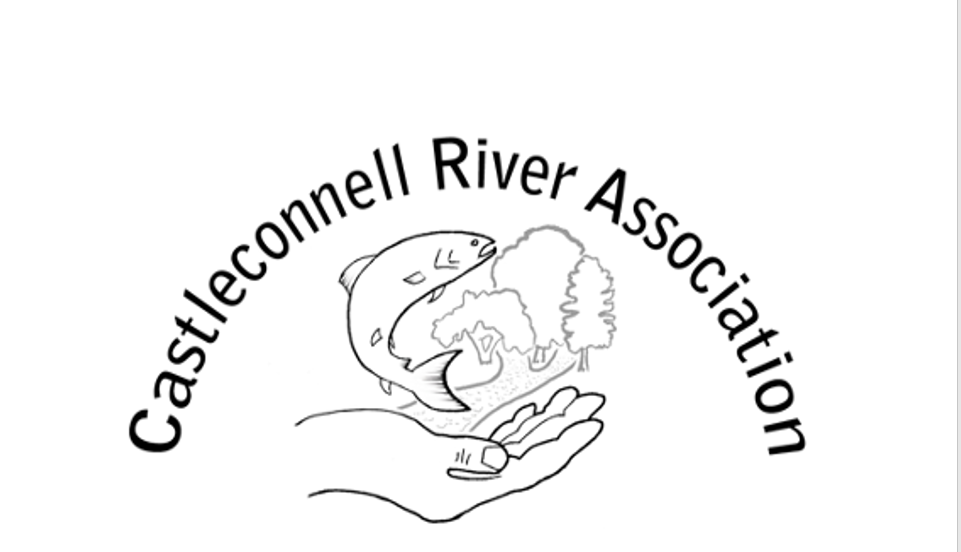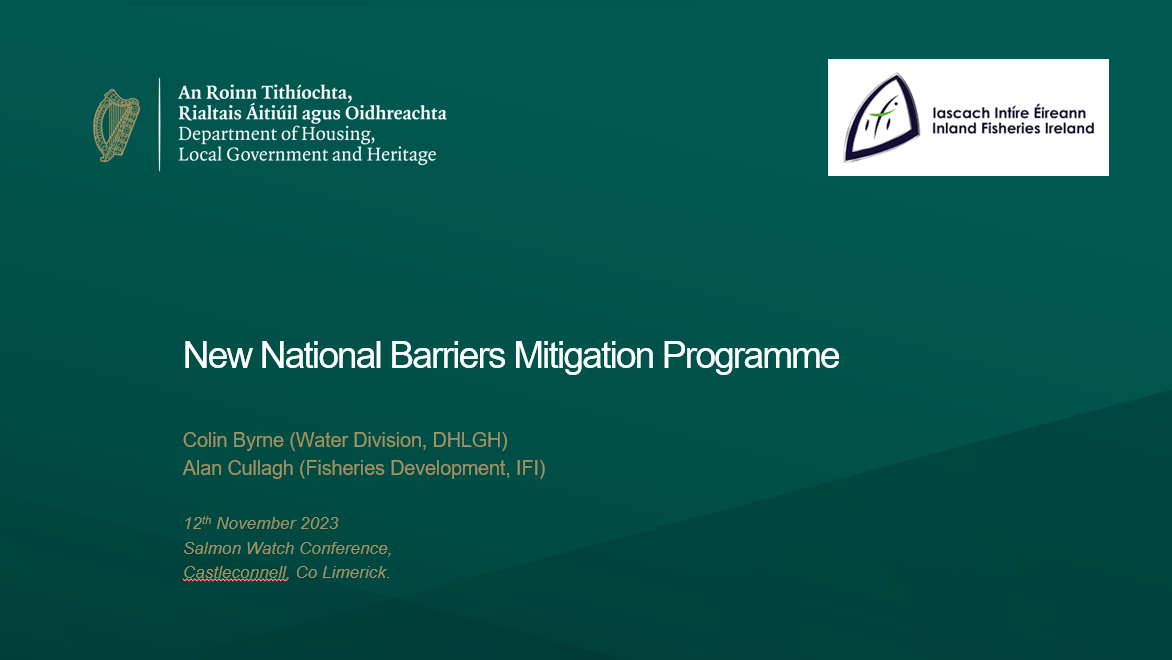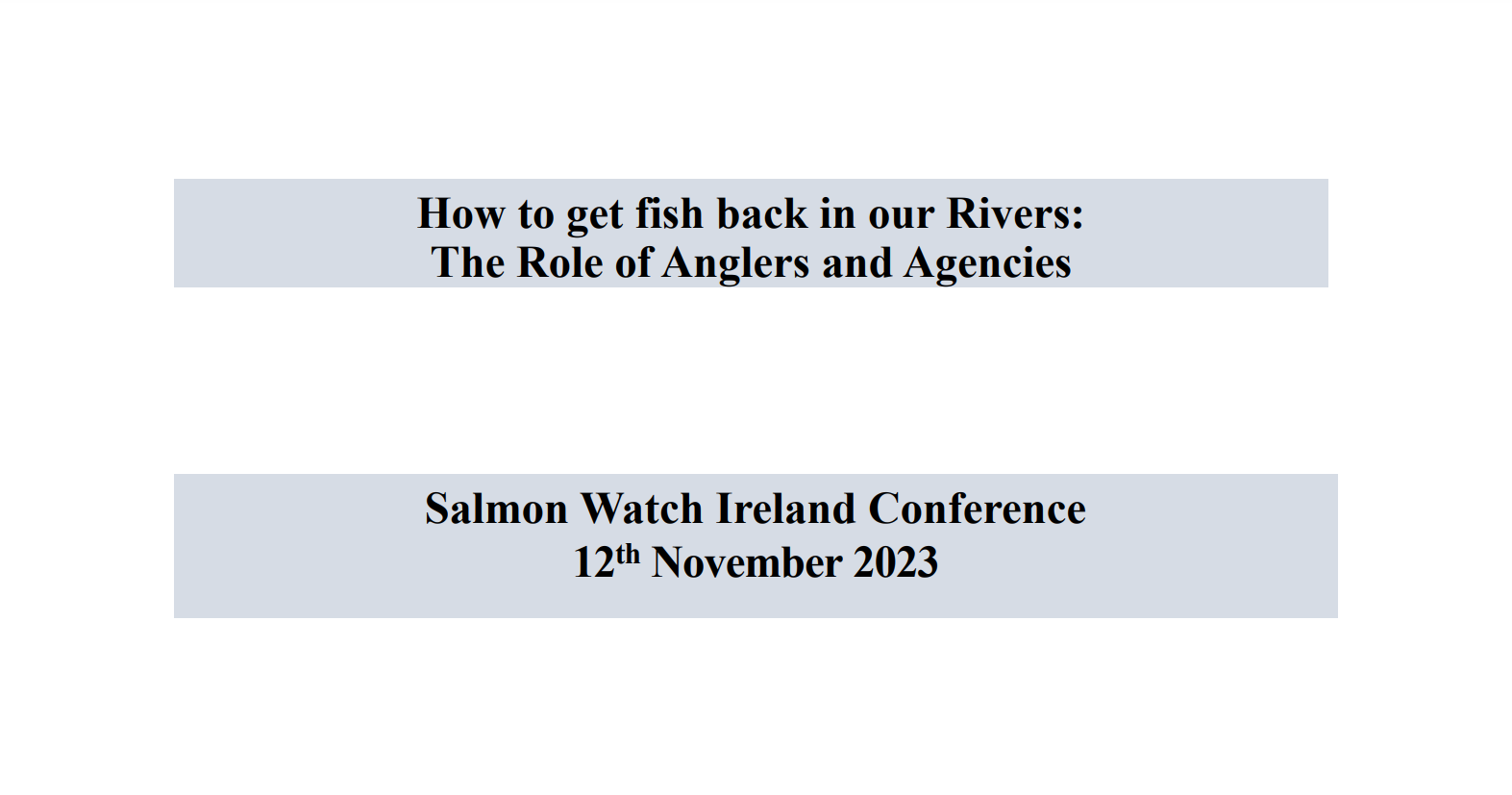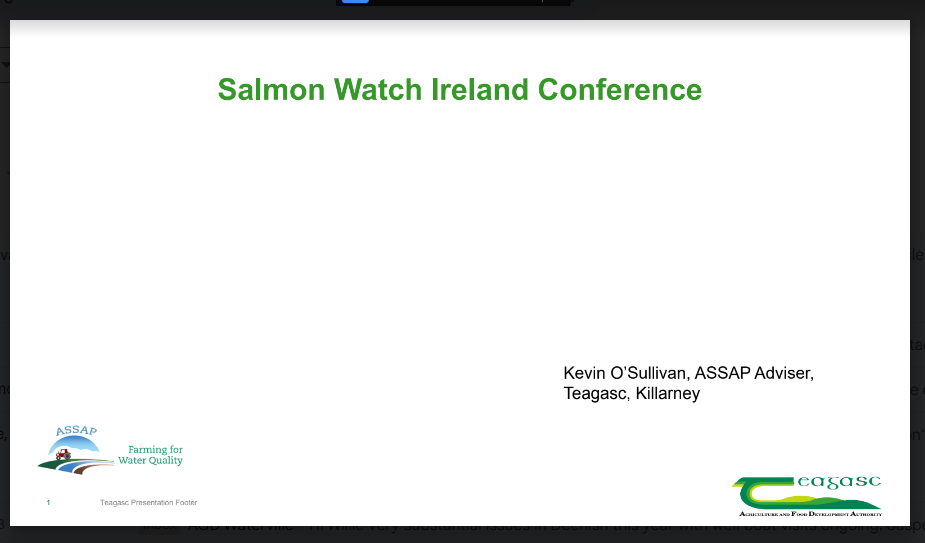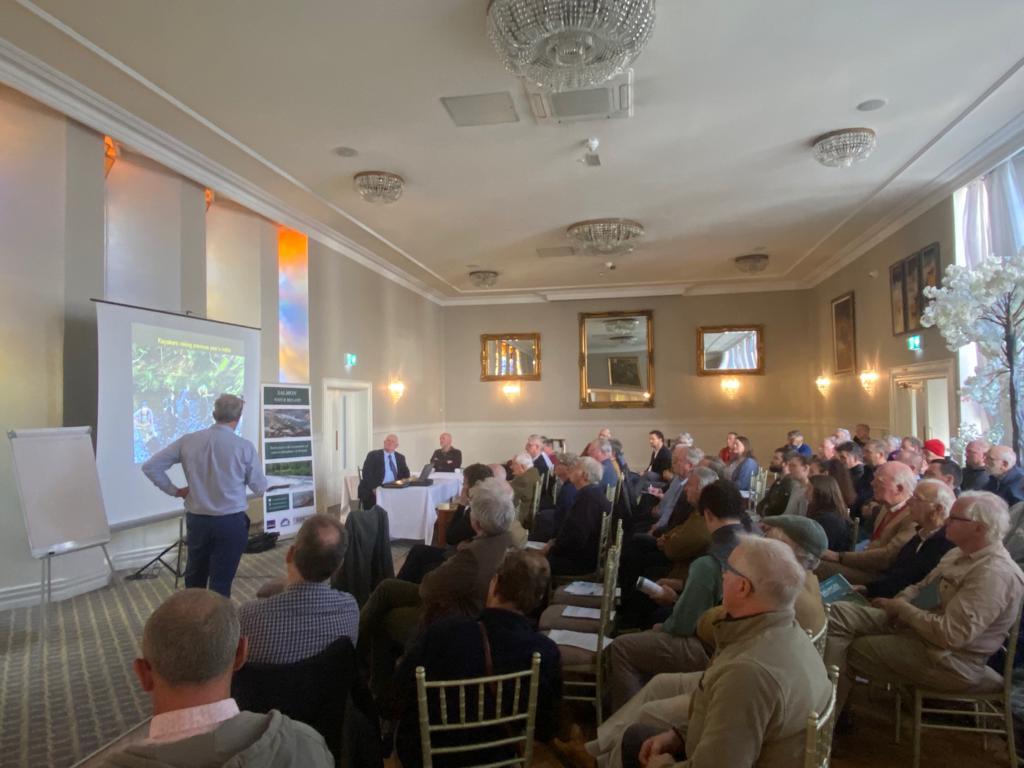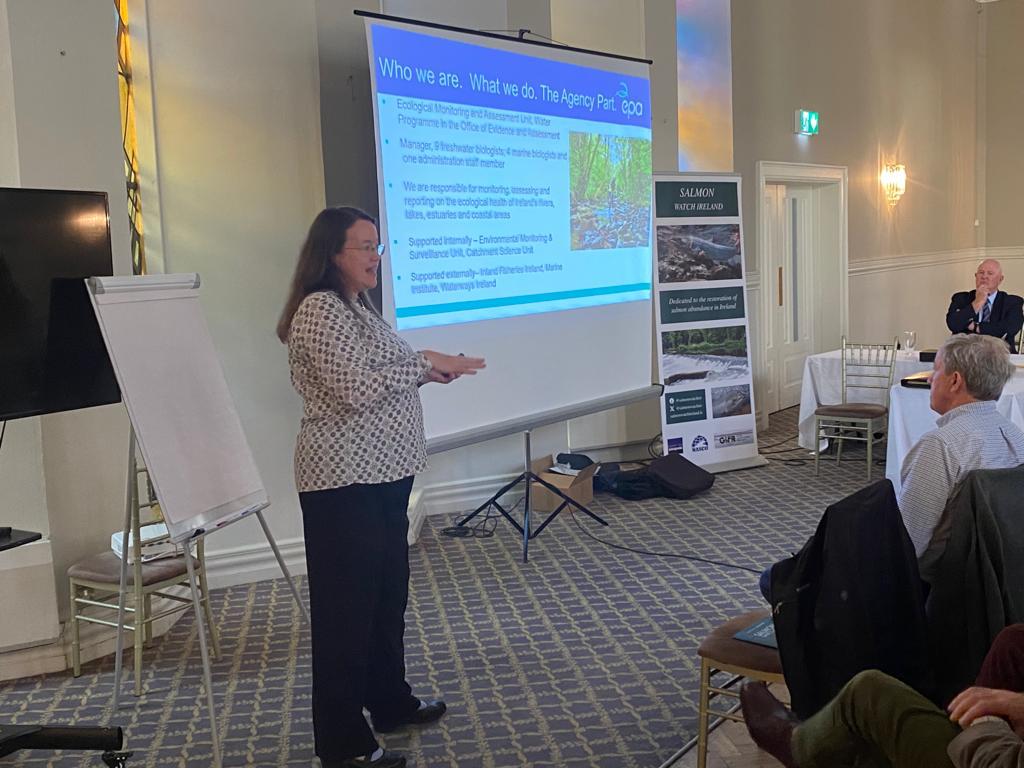Opening Remarks - Chair Salmon Watch Ireland
Salmon Watch Ireland welcomed over seventy attendees on the 12th November to the historic Castleconnell area, much vaunted throughout history as one of Irelands great fisheries and historically to some of Irelands largest salmon.
Unfortunately, the Shannon catchment has over the past century been impounded by the Ardnacrusha Dam and Parteen weir which have all but eradicated the unique salmon population which once inhabited this great river.
The good news even if somewhat frustrating time period it is taking to bring to fruition is that there is some semblance of progress going forward with the Shannon Connectivity Project.
It is also very significant that the local fisheries development group here in Castleconnel has had such success over the years in regard to habitat regeneration and indeed were a recipient of Salmon Watch Ireland “Salmon Hero Award” a number of years ago.
Just an update on our various activities to date. As you are aware we have spent considerable resources and finance on a Judicial Review in regard to Bantry Bay. A decision is awaited and may be to hand prior to Christmas.
We continually highlight our opposition to open cage farming at sea and we are seeing some positive although painfully slow responses from the EU on our complaint. This is primarily as a result of a lack of cooperation by the Department of Agriculture, Food, and the Marine with EU authorities.
Our policy document has been circulated to you today which outlines our vision of salmon management going forward.
The purpose of our conference today is as always to inform and help salmon stakeholders and the general public to keep abreast of current activities and future plans which agencies and volunteers can learn from.
We are in the business of putting groups into a position in which they can cooperate and learn from each other.
It is not an overstatement to suggest that 2023 has seen a very definite collapse in Atlantic salmon stocks returning to our shores. It is also noteworthy that this was also reflected in the majority of countries which host populations of wild Atlantic salmon.
This would appear to indicate a large-scale issue at sea which is either the result of climatic influences or is suggestive of large-scale bye catch or illegal activities or indeed a combination of both during the oceanic phase. There is a growing acknowledgement by ICES and NASCO that there may well be a significant problem with bye catch within the pelagic fishery.
However, it is quite evident that marine temperatures off our own coast and at migration corridors and feeding areas are reflective of ongoing climatic changes which may impact on salmon survival and growth. It is noteworthy that historically a lower oceanic temperature regime suggests salmon survive better and in greater numbers rather than a situation where oceanic temperatures are warmer. Weakening Atlantic currents may also have a negative effect on smolt migration.
As the majority of Atlantic salmon juveniles spend up to two years in freshwater it is becoming increasingly clear that predation is becoming a substantial issue within rivers and is certainly not helped by a shift of rainfall patterns which mitigate against successful migration of smolts to sea during April and May.
It is also clear that smolts that are delayed in their migration suffer increased mortality at sea through a mismatch in timing of entry to the ocean. We are also very concerned that illegal exploitation of dwindling stocks is continuing in rivers or in coastal areas and with decreasing numbers is very significant in regard to future potential returns. It must also be a worry that smolts may be going to sea at an earlier age and indeed smaller size. Studies have revealed that larger smolts appear to survive better which is significant in light of warming freshwater temperatures.
It is our stated mission to help bring salmon back to abundance in Ireland's rivers and this was our hope when driftnet fisheries were closed However no significant rebound of stocks has occurred. It is again not an overstatement to say we have reached a crisis point and our focus now must be to preserve enough spawning fish to guarantee the very future of Atlantic salmon.
To this end we have met with Inland Fisheries Ireland to discuss conservation issues specifically how the scientific process is formulated to arrive at harvestable surpluses, and we have made recommendations to improve the process. We have indicated that the stock and habitat situation is much changed since this whole scientific process was designed and needed radical overall. It is obvious that the exploitation of salmon must again be reduced through a radical rethink on whether commercial exploitation is warranted or desirable considering the rapid decline of stocks while also minimising exploitation by all stakeholders. We need directed conservation in regard to larger MSW fish and indeed is it desirable that exploitation continues in month of September when fish are preparing to enter the latter stages of their freshwater journey. We have suggested major changes to Inland Fisheries Ireland in regard to the recreational fisheries and we are very happy to see a voluntary effort on many catchments to protect salmon through catch and release policies and limiting harvest options.
While reducing exploitation may not give us an anticipated upsurge in stocks it may help to partially alleviate pressures at sea. We certainly need the majority of salmon to be allowed to spawn successfully. We need everyone to understand that we need many more wild healthy smolts to get to sea, but without an adequate numbers of spawners and conditions which are optimum to allow their progeny survive, this will not happen.
With the recent EPA REPORT noting a deterioration in river water quality it is incumbent on all agencies and individuals to work together. This conference allows all of us to see at first hand how best we can cooperate.
However, without the optimum conditions instream it might all be in vain and this brings us on nicely to today which we hope will give an insight to how agencies and local groups are working to improve water quality through targeted actions and how stakeholders are giving of their time to improve habitat and help in producing suitable conditions to enhance salmonid populations.
We gratefully acknowledge the financial support of LAWPRO in hosting this conference, and we thank the speakers for their time and effort in preparing their presentations.
Declan Cooke, Inland Fisheries Ireland
The presentation by Inland Fisheries Ireland focussed on how their approach has changed to take into account a strategy of using soft engineering rather than the older strategy of using hard engineering to aid recovery of damaged river channels. The concept of building a channel within a damaged channel and the focus on riparian zone management and upslope management were very relevant with climate and agricultural intensification being factors in all works in the modern era. 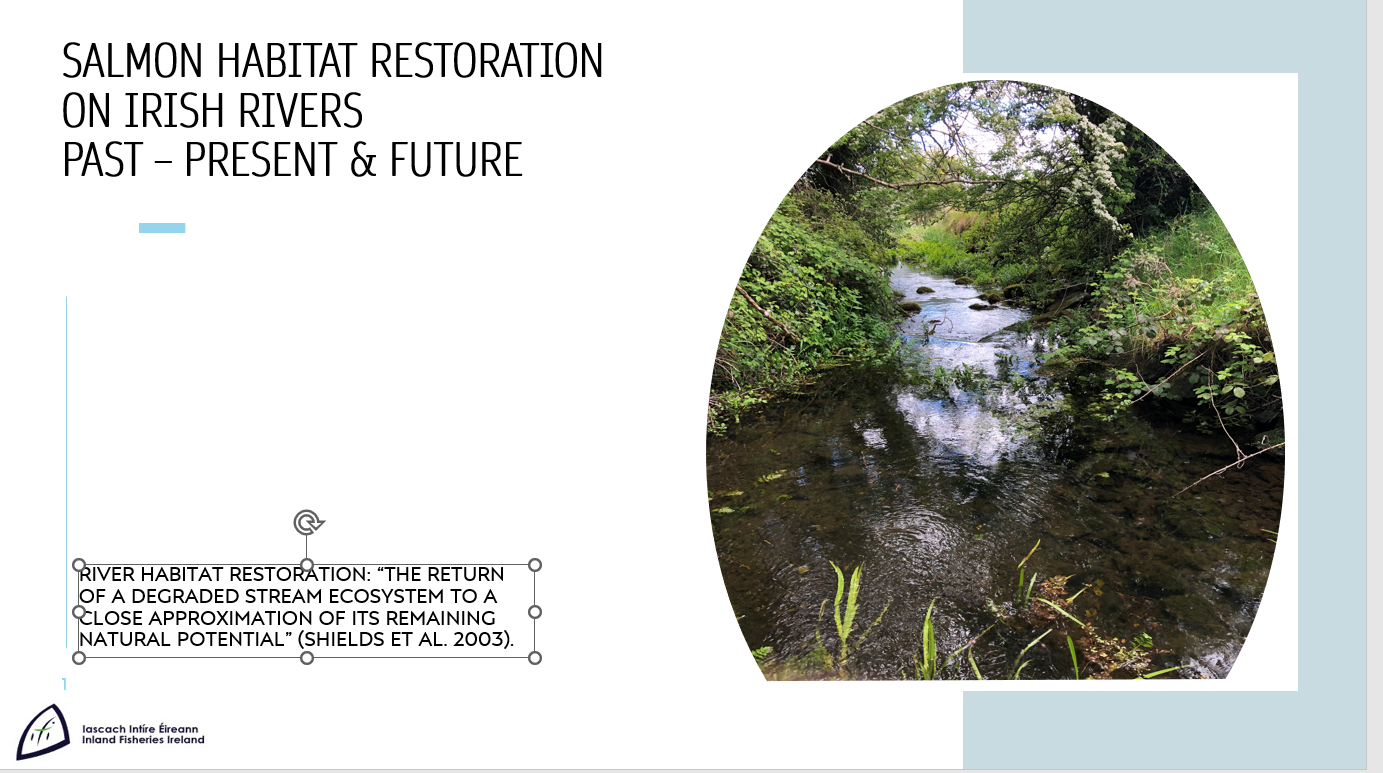
Pat O Toole - Trim, Athboy and District Anglers
The Boyne was one of Irelands greatest salmon rivers. Unfortunately large scale drainage during the late 1960's up to the 1980's destroyed large tracts of river bed and ongoing drainage maintenance still has a detrimental influence on the ecology of this very important river. In 2014 Pat O Toole and Ciaran Kelly along with the ever willing team from Trim, Athboy and District Anglers commenced a program of works which continues to this day. It is an example to all that this initiative is driven by concerned angling interests with conservation to the forefront of all their work.They have worked in conjunction with the OPW and IFI to gain funding and practical help in their program of works and certainly it is an example of stakeholder involvement and cooperation with agencies. This is an example to all what can be achieved by conservationists working at a local level with limited funds and how agencies can facilitate these works in a practical way. The work carried out on the Boyne and its tributaries would not have been so successful without the help of the local staff of Inland Fisheries Ireland and the Office of Public Works and the local staff need to be congratulated for their help in achieving so much in a spirit of local cooperation.
Simon Molloy - Suir Tributary Enhancement Projects
The work of Salmon and Trout River Enhancement Work Ltd - River Suir is a shining light in regard to rehabilitation of riparian and instream works in a very challenging environment. The work carried out in areas of intensive agriculture aptly demonstrates that cooperation between landowners, agencies and the voluntary sector results in many works coming to fruition for the betterment of salmon and trout conservation.
From stabilisation of river banks and the use of specialised machinery this group is at the forefront of conservation efforts. Shading is a very large issue in a number of tributaries on the Suir and they have managed to improve and enhance the ecology of the various important spawning areas on the Suir. The Suir is probably one of the best producers of smolts in Ireland and needs constant attention and it is testimony to this group that they have kept going for well over 20 years.
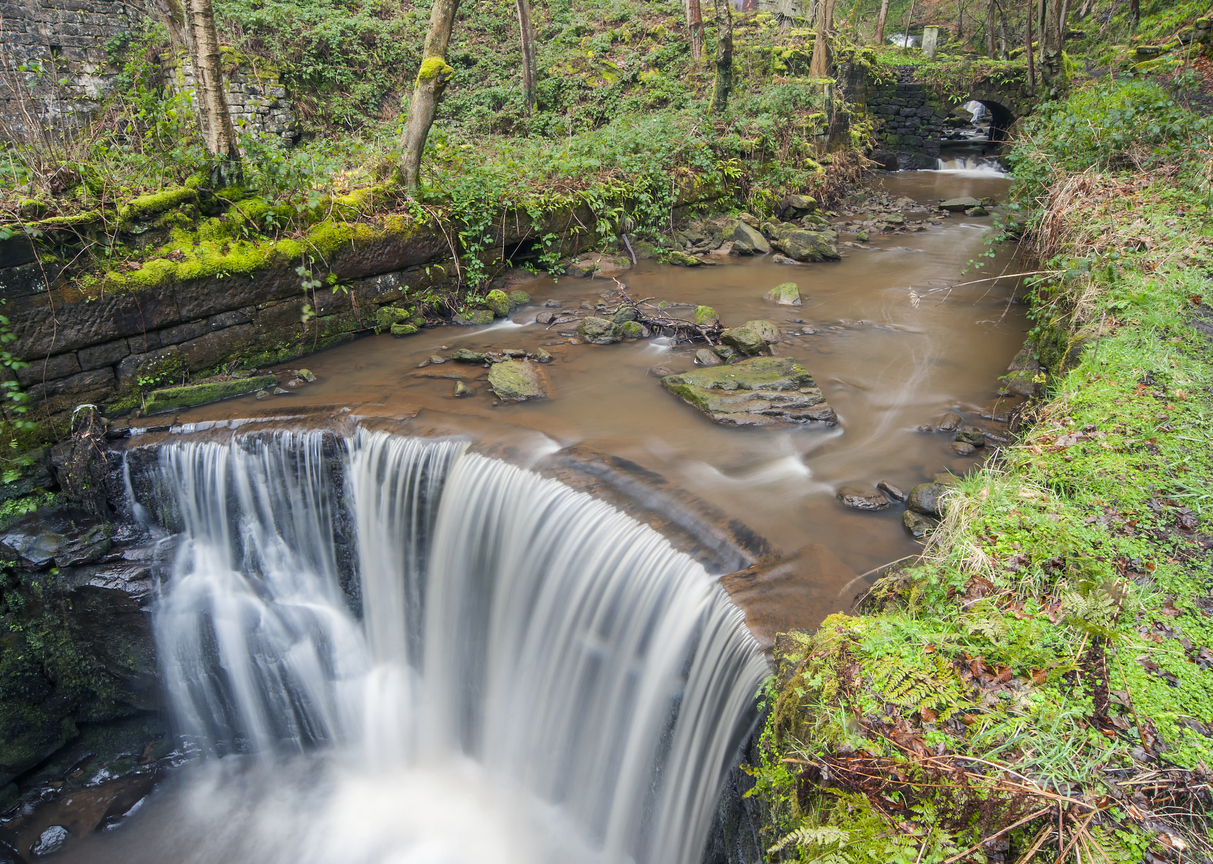 Remediating the Lower Shannon at Castleconnell - Pat O Connor, Castleconnell River Association
Remediating the Lower Shannon at Castleconnell - Pat O Connor, Castleconnell River Association
The work of the Castleconnell River Association is extremely valuable in that it allows some wild Atlantic salmon to spawn in an area below Parteen Dam along the old river channel. The area of the old river channel is ecologically challenged by the water management regime through Parteen Dam. The flow by statute only requires a minimum flow at 10 cubic meters per second and this has resulted in a very different hydrological regime. In high floods, water is spilled through the Parteen Dam resulting in damaging river conditions which can affect spawning and nursery habitats and this is where the Castleconnell River Association has worked tirelessly over the past decade to remediate spawning channels and improve access to streams where salmon have traditionally spawned.
A new national barriers mitigation programme - Colin Byrne Department of Housing
This presentation gave all attendees sight of the very large task ahead to tackle hydro-morphology issues related to man made structures within rivers. It was a very enlightening to see at first hand the enormous amount of barriers that impact fish migration throughout Ireland. The planning and environmental challenges would suggest that these issues will take many decades to remedy. It was encouraging to see that large scale finances are available.
LAWPRO: Supporting a Community Based Approach to River Restoration, Riparian Management & Water Quality - Ruairi O Conchuir
To support a community-based approach to the restoration of salmonid rivers, to support better riparian management and to undertake work to enhance instream habitat, riparian biodiversity and improve water quality, a community group needs to work in an integrated manner to ensure it has:
- A planned approach with multiple stakeholders.
- Is working with natural processes.
- Incorporates good science and a catchment-based (or sub-catchment based) science approach.
- Is constantly assessing successes and problems.
- Willingly shares its experiences to benefit others.
- Is constantly communicating its work and the lessons learnt (and indeed failings.)
- Is addressing perceptions of river restoration (flood plain connectivity, flooding, etc., etc).
- Always adopts an evidenced based approach and learns and grows from this approach.
- Works as scale that is sufficient for the ecosystem functioning of that river.
- Always attempts to bring about multiple benefits (river restoration, habitat enhancement, biodiversity, climate resilience, etc) with realistic targets.
Agricultural Impacts on Water Quality and Funding for Remediation.- Kevin O Sullivan, Teagasc
This presentation gave attendees the basis for understanding the main pathways that agriculture can contribute to polluting water courses throughout Ireland. The main focus was on the various pathways through point sources, nutrient transfer, hydro-morphology and chemical inputs. The various sources of funding available to the farming community to mitigate pollution was also a strong focus of the presentation.
Water Quality in Ireland - Doctor Deirdre Tierney , Environmental Protection Agency
The focus of this presentation demonstrated that water quality in our rivers, lakes and estuarine waters has continued to decline. The largest contributor was agriculture due primarily to intensification of dairy sector. However other contributors were noted with urban waste water an issue. The largest deterioration appears to be estuarine waters primarily caused by excessive nitrogen input.
Salmon Hero Award - 2023
The annual award for 2023 goes to Salmon and Trout River Enhancement Work Ltd - River Suir. This group has consistently worked for the betterment of water quality and salmonid habitat over a considerable length of time focussing on the River Suir and its catchment tributaries. They have through their work and advice heralded many other groups to take action on their own catchments. The group are working in an area which has considerable problems relating to hydro-morphology and their unique use of machinery without impacting instream processes is surely a scheme to be rolled out nationally to remedy serious impacts of shading on valuable salmonid nursery areas.
We hope that you use the presentations as a reference to help in the restoration of salmon to Ireland's rivers. We as always are available to help in all aspects of salmon conservation.





